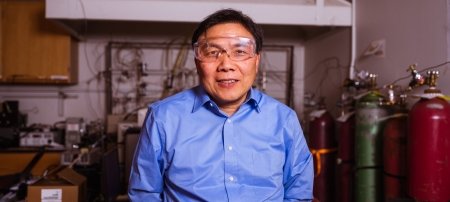Michigan Tech Breakthrough Could Slash R&D Time for Next Generation of Hydrogen Fuel Cells

It took Thomas Edison two years and over 3,000 experiments to develop a marketable light bulb. It has taken 10 times that long and who-knows-how-many experiments to develop a system that is far more complicated: the inner workings of a reliable, marketable hydrogen fuel cell.
Now a research team led by Jeffrey Allen of Michigan Technological University is nearing development of a mathematical model that will slash that R&D time and effort. It focuses on water, a fuel cell’s worst enemy.
Water vapor is the only emission coming out of the tailpipe of a hydrogen fuel cell-powered vehicle, a big reason why fuel cells are so attractive. But moving that water out of the fuel cell can be a soggy problem. Just a teaspoon can kill the reaction that drives hydrogen fuel-cell powered vehicles. And, considering that it can take a stack of dozens of fuel cells to power a car, and a single flooded cell can take down the entire stack, water management becomes a looming issue.
Most of that watery action happens in the fuel cell’s porous transport layer, or PTL, which is not much thicker than a coffee filter. That’s where all the byproducts of the fuel cell’s power-generating reaction meet up with a catalyst and react to form water vapor.
It’s not easy to find out exactly what’s happening in the PTL. “Everything is compressed like crazy,” says Allen, the John F. and Joan M. Calder Associate Professor in Mechanical Engineering. “You have to get the gases—hydrogen and air—to the catalyst, and you have to get the water away. Figuring out how to do this has largely been a matter of trial and error.”
The latest generation of hydrogen fuel-cell engines does an excellent job of managing water, but as new materials and designs enter the arena, the industry is again faced with a long, costly experimental process to determine the best configuration.
“There’s a whole new class of catalysts coming out, and we want to make sure it doesn’t take another 20 years to optimize the materials set,” says Allen.
Optimizing those up-and-coming materials to get rid of water is especially difficult, because the movement of water in the PTL appears to be random. “But that’s what we’re trying to predict,” he says.
At high flow rates, water spreads out evenly. But when the flow rate is low, as it is in an operating fuel cell, it spreads out in irregular shapes like an amoeba, a process called “fingering.” Other factors come into play as well, including how saturated the PTL is.
Allen’s team incorporated those variables into a mathematical model with the aim of forecasting the movement of water. Then they tested it using four different types of PTL and found that they could predict how water would behave with a high degree of accuracy.
“We were really excited,” Allen says. “This is the first time anyone has validated a model in a real sample. We’re at the point where, by adjusting just one parameter, we are able to duplicate experimental results exactly.”
Now, the group has incorporated temperature and evaporation into their model to make it an even better tool for fuel cell designers.
Allen and Ezequiel Medici, a Michigan Tech PhD graduate and postdoctoral research fellow, have published an article on their work, “Scaling Percolation in Thin Porous Layers,” in the journal Physics of Fluids, which was published online Dec. 23, 2011. Allen presented a paper on their most recent work, “Pore-Level Simulation of Multiphase Water and Thermal Transport in Low Temperature Fuel Cells,” at the Paul Scherrer Institute, in Switzerland.
Their work was supported by the US Department of Energy with additional funds from the John F. and Joan M. Calder Associate Professor in Mechanical Engineering and Michigan Tech’s Department of Mechanical Engineering-Engineering Mechanics.
Michigan Technological University is an R1 public research university founded in 1885 in Houghton, and is home to nearly 7,500 students from more than 60 countries around the world. Consistently ranked among the best universities in the country for return on investment, Michigan's flagship technological university offers more than 120 undergraduate and graduate degree programs in science and technology, engineering, computing, forestry, business, health professions, humanities, mathematics, social sciences, and the arts. The rural campus is situated just miles from Lake Superior in Michigan's Upper Peninsula, offering year-round opportunities for outdoor adventure.




Comments